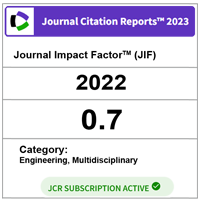COMPARISON OF TWO TYPE OF FUZZY SLIDING MODE WITH REGION TRACKING CONTROL FOR AUTONOMOUS UNDERWATER VEHICLE
DOI:
https://doi.org/10.11113/jt.v74.4809Keywords:
Underwater vehicle, sliding mode control, fuzzy logic, region trackingAbstract
This paper presented two type of fuzzy sliding mode control with region tracking control for a single autonomous underwater vehicle. The vehicle is needed to track a certain moving region whilst under the influence of wave current. The first fuzzy logic proposed is used to tune the gain and to reduce the chattering effect; the signum function is replaced by saturation function. In second fuzzy type sliding mode controller, the switching term or reaching law is modeled using fuzzy logic. Simulation result is presented to demonstrate the performance of the two proposed tracking control of the AUV and the performance is compared.     Â
References
Takegaki, M. and Arimoto, S. A. 1981. New Feedback Method for Dynamic Control of Manipulators. ASME Journal of Dynamic Systems, Measurement and Control. 103(2): 119-125,
Li, X. Hou S. P. and Cheah, C. C. 2010. Adaptive Region Tracking Control for Autonomous Underwater Vehicle. Proc of the 11th Int. Conf. on Control, Automation, Robotics and Vision, Singapore.
Hou, S. P. Cheah C. C. and Slotine, J. J. E. 2009. Dynamic Region Following Formation Control for a Swarm of Robots. Proc. of the 2009 IEEE Int. Conf. on Robotics and Automation.
Ismail, Z. H. and Dunnigan, M. W. 2011. A Region Boundary-Based Control Scheme for an Autonomous Underwater Vehicle. Ocean Engineering. 38(17-18): 2270-2280.
Santhakumar, M. and Asokan, T. 2011. Investigation on The hybrid Tracking Control of an Underactuated Autonomous Underwater Robot. Advanced Robotics. 24(11): 1529-1556.
Bessa, W. M. Dutra M. S. and Kreuzer, E. 2010. An Adaptive Fuzzy Sliding Mode Controller for Remotely Operated Underwater Vehicles. Robotics and Autonomous Systems, 58(1):16-26.
Soylu, S. Buckham, B. J. Podhorodeski, R. P. 2008. A Chattering-Free Effect Sliding-Mode Controller for Underwater Vehicles with Fault-Tolerant Infinity-Norm Thrust Allocation. Ocean Engineering. 35: 1647-1659.
Bing Sun, Daqi Zhu and Weichong Li. 2012. An Integrated Backstepping and Sliding Mode Tracking Control Algorithm for Unmanned Underwater Vehicles. UKACC International Conference on Control.
John, R. Coupland, S. 2007. Type-2 Fuzzy Logic: A Historical View. Computational Intelligence Magazine, IEEE. 2(1): 57-62.
Bo Hu, Hai Tian, Jiani Qian, Guochao Xie, Linlang Mo and Shuo Zhang. 2013. A Fuzzy-PID Method to Improve the Depth Control of AUV. Proceedings of 2013 IEEE International Conference on Mechatronics and Automation, Takamatsu, Japan. 4-7 August 2013.
Wei Zhang, Hongtao Wang, Xinqian Bian, Zheping Yan and Guoqing Xia. 2012. The Application of Self-Tuning Fuzzy PID Control Method to Recovering AUV. IEEE Oceans.
Lakhekar, G. V. and Saundarmal, V. D. 2013. Novel Adaptive Fuzzy Sliding Mode Controller For Depth Control of an Underwater Vehicles. 2013 IEEE International Conference on Fuzzy Systems (FUZZ), 7-10 July 2013.
Shuxiang Guo, Juan Du, Xichuan Lin, Chunfeng Yue. 2012. Adaptive Fuzzy Sliding Mode Control for Spherical Underwater Robots. 2012 International Conference Mechatronics and Automation (ICMA), 5-8 Aug. 2012. 1681-1685.
Fossen, T. I. 1994. Guidance and Control of Ocean Vehicles. 1st. edition ed. New York: John Wiley and Sons.
Neha Kapoor and Jyoti Ohri. 2013. Fuzzy Sliding Mode Controller (FSMC) with Global Stabilization and Saturation Function for Tracking Control of a Robotic Manipulator. Journal of Control and Systems Engineering. 1(2): 50-56.
Choi, S. Yuh, J. and Keevil, N. 1993. Design of Omni-Directional Underwater Robotic Vehicle. OCEANS ’93, Engineering in Harmony with Ocean, Proc.
Downloads
Published
Issue
Section
License
Copyright of articles that appear in Jurnal Teknologi belongs exclusively to Penerbit Universiti Teknologi Malaysia (Penerbit UTM Press). This copyright covers the rights to reproduce the article, including reprints, electronic reproductions, or any other reproductions of similar nature.





